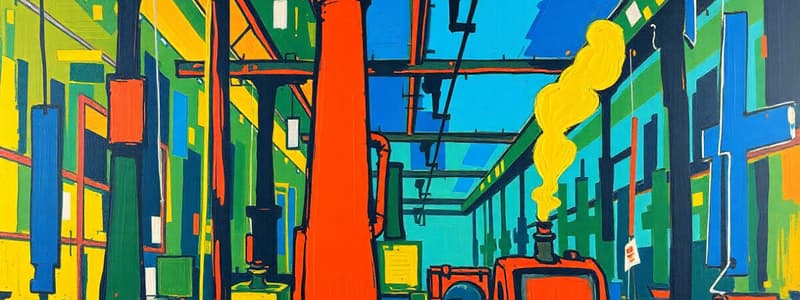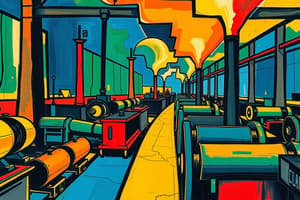Podcast
Questions and Answers
What was a significant effect of the Agricultural Revolution on the population?
What was a significant effect of the Agricultural Revolution on the population?
- Decreased availability of jobs in cities
- Higher death rates from famine
- Increased birth rates due to healthier mothers (correct)
- Increased average lifespan
Which factor did NOT contribute to the start of the Industrial Revolution in England?
Which factor did NOT contribute to the start of the Industrial Revolution in England?
- Strong colonial empire for resources
- Access to capital from wealthy merchants
- High levels of natural energy sources
- Significant industrial competition from Asia (correct)
What was one consequence of the energy revolution during the Industrial Revolution?
What was one consequence of the energy revolution during the Industrial Revolution?
- Decreased production capacity in factories
- Greater emphasis on agricultural outputs
- Faster production of goods due to new machines (correct)
- Increased reliance on manual labor
What role did geography play in England's industrialization?
What role did geography play in England's industrialization?
What impact did the population explosion have on industrialization?
What impact did the population explosion have on industrialization?
What time did the children start their night shift?
What time did the children start their night shift?
What was the earning of the youngest sisters for a night of work?
What was the earning of the youngest sisters for a night of work?
What primary reason led people to move to cities during the Industrial Revolution?
What primary reason led people to move to cities during the Industrial Revolution?
What term describes the movement of people from rural areas to cities?
What term describes the movement of people from rural areas to cities?
How long have the oldest three sisters been working in the mill?
How long have the oldest three sisters been working in the mill?
What is a potential consequence of rapid urbanization during the Industrial Revolution?
What is a potential consequence of rapid urbanization during the Industrial Revolution?
What did Furman Owens express about his education?
What did Furman Owens express about his education?
What was one result of the development of machines during the Industrial Revolution?
What was one result of the development of machines during the Industrial Revolution?
What was a direct consequence of the large labor supply during the Industrial Revolution in England?
What was a direct consequence of the large labor supply during the Industrial Revolution in England?
Which resource became increasingly important during the Industrial Revolution for powering machines?
Which resource became increasingly important during the Industrial Revolution for powering machines?
What did the factory system replace?
What did the factory system replace?
How did the Industrial Revolution impact social mobility?
How did the Industrial Revolution impact social mobility?
What effect did factories being located near sources of power have on their development?
What effect did factories being located near sources of power have on their development?
What characterized the work environment in factories during the Industrial Revolution?
What characterized the work environment in factories during the Industrial Revolution?
What role did young children play in coal mining during the Industrial Revolution?
What role did young children play in coal mining during the Industrial Revolution?
How did the introduction of the steam engine impact factory locations?
How did the introduction of the steam engine impact factory locations?
What was a major contribution of Friedrich Engels regarding urban pollution?
What was a major contribution of Friedrich Engels regarding urban pollution?
Which age group received the highest wages according to the factory wages in Lancashire?
Which age group received the highest wages according to the factory wages in Lancashire?
What was the main goal of Karl Marx's ideology?
What was the main goal of Karl Marx's ideology?
What was one outcome of the Factory Act of 1833?
What was one outcome of the Factory Act of 1833?
What class primarily consisted of landholding peasants and farm laborers?
What class primarily consisted of landholding peasants and farm laborers?
Which of the following was NOT a reform that emerged during the Industrial Revolution?
Which of the following was NOT a reform that emerged during the Industrial Revolution?
What concept best describes the economic principle of laissez-faire?
What concept best describes the economic principle of laissez-faire?
Which statement is a common misconception about the socio-economic divide during the Industrial Revolution?
Which statement is a common misconception about the socio-economic divide during the Industrial Revolution?
What was one benefit won by labor unions during the Industrial Revolution?
What was one benefit won by labor unions during the Industrial Revolution?
Which factor contributed most to the conflict between the bourgeoisie and the proletariat, according to Marx?
Which factor contributed most to the conflict between the bourgeoisie and the proletariat, according to Marx?
Flashcards are hidden until you start studying
Study Notes
The Industrial Revolution
- The Industrial Revolution began in the 1750s when people transitioned from home-based or farm-based production to mass production in factories located in cities.
Causes of Industrialization
- Agricultural Revolution: Small farms were enclosed, creating large, profitable farms. New farming methods and machinery increased agricultural production, leading to more food and a surplus of labor.
- Population Explosion: Improved nutrition, healthcare, and reduced death rates resulted in a population boom. This increase in people created a need for jobs and a growing demand for goods.
- Energy Revolution: New machines, powered by water wheels and coal-fueled steam engines, enabled mass production of goods. These inventions led to faster production and the creation of new products.
Why Great Britain?
- Colonial Empire: Colonies supplied Britain with raw materials and served as markets for finished goods, contributing to the growth of British businesses.
- Capital: Wealthy merchants had capital to invest in factories, equipment, and new technologies.
- Geography: Britain's island status provided good access for trade. Irregular coastlines offered numerous harbors and ports, while mild temperatures allowed for year-round trade.
- Large Labor Supply: The population explosion and displacement of farmers from agricultural land created a pool of labor for factories.
- Natural Resources: Abundant coal and iron ore provided fuel and raw materials for industrial production.
- New Technology: Innovations in textiles, transportation, and communication contributed to the growth of industries.
- Stable Government & Economy: England's political and economic stability provided a foundation for industrial growth.
The Basics of an Industrialized Society
- Rural to Urban Shift: Economies transitioned from agriculture to urban, machine-based manufacturing.
- Wage Employment: People no longer worked for a share of crops but earned wages in factories.
- Urbanization: People migrated from farms to cities in search of work, leading to urban growth.
- Social Mobility: The industrial revolution promoted social mobility, allowing people to raise or lower their social status based on their work and abilities.
The Factory System
- Centralized Production: Factories concentrated production in one place, often near power sources.
- Capital Investment: Factories required significant capital investment, surpassing the need for skilled labor.
- Rigid Schedules: Workers faced long, 12-14 hour workdays with strict, rigid schedules.
- Monotonous Work: Factory work often involved repetitive, monotonous tasks that could be tedious.
The Use of Coal
- Steam Engine: By 1800, the steam engine, powered by coal, replaced water wheels as the primary power source for factories.
- Factory Relocation: Factories moved closer to sources of raw materials, workers, and ports, fueled by the accessibility of coal.
- Urban Growth: Cities grew around factories built near coal and iron ore mines in central England.
Child Labor in the Mines
- Hurriers: Children, often as young as 4, worked as "hurriers," pulling and pushing tubs of coal in dangerous mine conditions.
Impact of Industrialization
- New Jobs: The industrial revolution created new jobs in factories and related industries.
- Lower-Priced Goods: Increased production led to lower prices for goods.
- Larger Markets: Improved transportation made it easier to deliver goods to distant locations, expanding markets.
- More Sales: Larger markets increased sales for factories.
- More Factories: Increased demand led to the construction of more factories to meet the growing needs of consumers.
- More Machinery: Factories invested in more machinery to increase production.
From Agrarian to Industrial Societies
- Growth of Rail Networks: By 1850, iron rail networks spread across Europe, further connecting cities and facilitating trade.
- Shift to Urban Life: By 1860 in the USA, a significant portion of the population had moved to cities, and agriculture played a smaller role in the economy.
The New Industrial City
- Urbanization: The movement of people to cities due to job opportunities in factories is known as urbanization.
- Housing Shortages: Cities struggled to provide sufficient housing, police services, and sanitation systems for the influx of new residents.
- Pollution: Untreated sewage and industrial waste polluted cities' air and waterways, creating serious health problems.
Factory Wages in Lancashire
- Low Wages: Workers, particularly women and children, earned very low wages in factories.
- Wage Disparity: Wages varied significantly based on age and gender with men consistently earning more than women.
"Upstairs" / "Downstairs" Life
- Social Class Divide: The industrial revolution led to a widening gap between the wealthy elite and the working class.
Social Classes
- Wealthy Elite (5%): Industrialists, bankers, merchants, and aristocrats with a significant share of wealth and influence.
- Middle Class: Lawyers, doctors, civil servants, business managers, professionals, and shopkeepers.
- Working Class/Lower Classes (80%): Peasants, laborers, skilled/unskilled workers, and domestic servants.
Capitalism
- Laissez-faire: The belief that the free market could regulate itself without government intervention.
- Free Competition: Businesses competed freely without government restrictions.
- Private Control: Individuals and businesses controlled the factors of production and made economic decisions.
Karl Marx and Communism
- Class Conflict: Marx believed that history was marked by conflict between social classes, specifically the bourgeoisie (owners of production) and the proletariat (workers).
- Proletariat Revolution: Marx proposed a revolution in which the proletariat would seize control of the means of production and create a society where everyone was equal.
Reforms during the Industrial Revolution
- Labor Unions: Workers formed unions to bargain with employers and strike if their demands were not met.
- Factory Act of 1833: Prohibited employing children under the age of nine, limited working hours for children to eight per day, and established safety standards for children.
- Mines Act: Prevented women and children from working underground, limited workday hours, and improved working conditions in mines.
- Victory for Labor Unions: Unions won victories in improving working conditions, wages, work hours, and safety standards for the working class.
Towards a Mass Society
- Improved Living Conditions: Efforts were made to improve housing, public sanitation, and education for the working class.
- Universal Education: Campaigns promoted universal education, making education more accessible to all.
Homework
- Expect a quiz on the French Revolution and the Industrial Revolution.
Studying That Suits You
Use AI to generate personalized quizzes and flashcards to suit your learning preferences.




